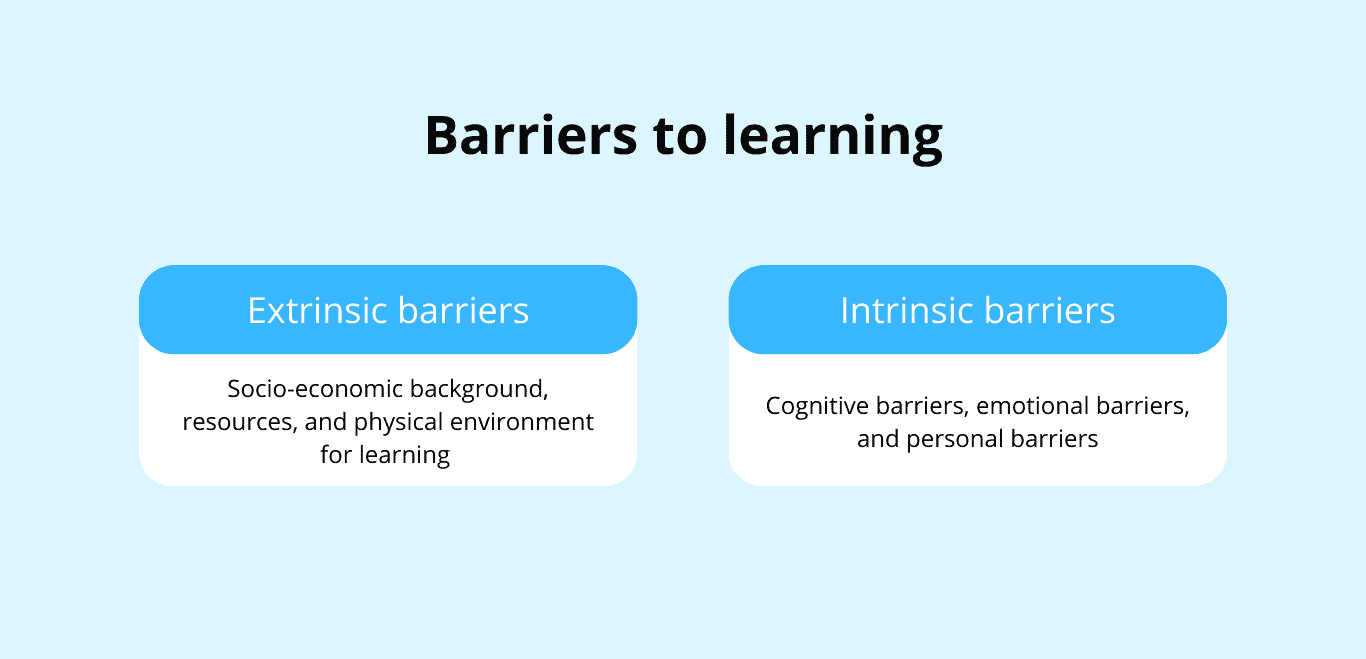If you are planning to create your first course, you need to be aware of a few things first. One of these things are the barriers to learning that your future participants might have. Learning barriers are obstacles that we might face – and need to overcome – when we are learning something new and want to reach a specific goal. Use this insight to design your course with different ways of learning and turn this barrier into a possibility for your course catalogue.
What are barriers to learning?
A barrier to learning can be a physical, emotional or cultural element that obstructs you from achieving those goals you have set for yourself in the learning process. Learning barriers are personal, cognitive, or social obstacles that can pop up anywhere, anytime and derail your learner experience.
Why you need to be aware of learning barriers
Barriers to learning can also happen to anyone, and are not segmented to certain locations. However, it is important to be able to identify them. As a course provider, you can implement solutions that will stimulate learning in other ways. As a learner, you can be aware of it and communicate better about which learning environments, tools or methods you need to learn optimally.
Remember that research shows that there are big discrepancies between what people experience as learning barriers. Especially grown adults are influenced by economic, personal, and social circumstances that impact how well they learn in certain environments. Therefore, it is important to pinpoint the motivation for learning.
We divide learning barriers into extrinsic and intrinsic
Extrinsic barriers to learning are external factors that will impact the learning process. It can be related to economic resources, which will affect access to computers and equipment. The physical space where learning is conducted, either at the workplace, at home, or online, will also affect the learning. Intrinsic barriers to learning include cognitive, emotional, and personal barriers, which stem from within and affect the chances one has to learn new knowledge or skills.
3 different barriers to learning and how you can overcome them
Let us deep dive into some learning barriers; we will go into depth about an extrinsic learning barrier, the learning barrier, and two intrinsic barriers: emotional and personal barriers.
Learning environment barriers to learning
If there is a problem with the learning environment, then this affects the entire learner experience. But luckily, there are some concrete solutions you can implement to combat this learning barrier.
The problem
You will most likely encounter a course where the course format or design is not ideal. It might not have been designed with the correct target group in mind, or the course materials are not being utilised in the manner it was intended.
The solution
If you want to improve the course format, you need to critically evaluate the content you are using and find more engaging alternatives. For example, a text-heavy course will benefit from videos or images that bring the text to life. You can communicate much more effectively if you combine videos with text, where the latter offers context to the rich media that video is.
Improve the learner experience further
Many find a learning management system (LMS) as the best solution to improve the learning experience. A good LMS has features that will keep participants engaged, like video training or progression insights. The FrontCore LMS allows participants to delve into a course that you have specifically designed for them down to the details.
Emotional barriers to learning
Emotional barriers can resurface in many forms. Oftentimes, it is related to a pressure that you feel from others or from within. For example, pressure from management, where their keenness on achieving certain goals does not take into account the learners’ ability to achieve those goals. As a learning provider, you need to find a solution that does not strengthen the barriers to learning that you can easily spot, already now.
The problem
The problem is either individually or a collective symptom of the workplace. It can be the fear of failure, which obviously no one finds comfortable. It can also be a result of miscommunication between various people and their desired goals, like the discrepancy between management and learning and development, which I mentioned earlier.
The solution
A great place to start is with the learning culture. It is essential to treat failure as an opportunity. Making mistakes is okay, in fact, it is a path to learning. You should also ensure that the culture of learning is open as well as structured. By making sure that all people in the company are aligned on which learner culture we want, it becomes easier for participants to spot the structure of learning, establish goals, and go with the flow.
Personal barriers to learning
Personal barriers to learning often come down to a lack of motivation. You have lost sight of why you are taking this course or why you are deep-diving into a new field and learning new skills.
The problem
Lack of motivation stems from a lack of defined goals. Goals need to be defined, mapped out and have a clear path of achievement. The course modules should also reflect what the employee wants to achieve.
The solution
If you are in charge of upskilling at your workplace, you need to ensure that there are clear training goals. By keeping employees and learners focused, the potential learning outcome will be valuable.
You should also consider using a training management system (TMS) to keep organised and administer all activities throughout the training sessions. This will also be a good arena for you to keep track of your course participants and their progress, especially if you integrate it with an LMS.

Motivation is key to learning.
4 extra learning barriers in an online course
When you are creating your online course, you need to consider some barriers that are unique to online courses.
Online distractions and other disruptions at home
It is easy to become distracted online, by focusing on other sites, or even worse, doom-scrolling on social media after receiving a notification you just had to respond to. Interruptions from family, flatmates, or a partner are other disruptive elements that make the home a place that is less conducive to learning.
Equipment and technical errors
No access to a functioning computer, poor internet connectivity, or problems with devices will be a huge, extrinsic barrier to online learning.
Communication challenges
Some struggle with communication online, where they are dependent on face-to-face interactions. In other cases, you are dependent on an instructor taking a more active role and managing the conversations. In both cases, it could be useful to implement blended learning methods and offer a combination of online and traditional learning.
Motivation
The lack of motivation is also something that is especially prevalent in online learning. Many do not even complete the online course they have signed up to, due to low motivation. Therefore, it is one of the key elements to think of when you are creating an online. The upside to digital learning is also the downside. You have the freedom and flexibility to learn wherever and whenever, and most of the time you have no one to control whether you attend or not. This can be a slippery slope if you feel the motivation slipping away.
Overcoming barriers to learning in your course
The solution to overcoming barriers to learning can be found in the course design. Either when you are creating an online course or a traditional learning session, you need to take time to understand your target audience and build your course to reflect their needs and the ways they learn the best. You should consider your learning methods, as people learn in different ways and the course should reflect their preferred methods.
For example, you can consider bite-sized learning, which is where you break up the learning sessions into smaller, more digestible chunks for the participants. This will increase your chances of keeping them engaged and interested, and ideally be better suited for how they soak up the information. You should also ensure that there is a balanced amount of video and text content. Check out the imagery and put some interactive, social elements in the course that will boost engagement.
List of factors to consider when overcoming learning barriers
- Lack of focus should be targeted with some strategic methods. Use the Pomodoro method, where you concentrate for time intervals, before you can have a short break. Ignore your phone and reserve time in your calendar to focus are other good advice.
- Disruptive mindsets where people feel disparaged to learn something new must be targeted in every situation. Focus the energy on addressing past experiences and ensuring that the learning environment is constructive and offers support from every participant.
- Lack of a sense of community is essential to combat in every workplace, which you can do by actively showing employees how they contribute to the company as a whole. Demonstrate to them where and how they are a resource and communicate how their personal development has a direct effect on the company performance.
By identifying and targeting the various barriers to learning, you can provide a better environment for learning. As a course provider, you want to see a positive result of overcoming learning barriers in the wellness of participants or employees, business performance, and workplace environment. As a learner and participant, you will experience higher levels of engagement and satisfaction from getting tools to combat barriers to learning. There are many fruits of your labour to enjoy if you put in the work.
Did you like this article? Don't forget to share it:







0 Comments